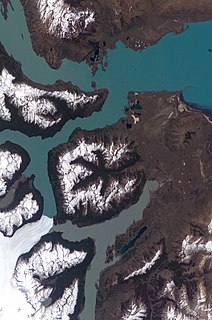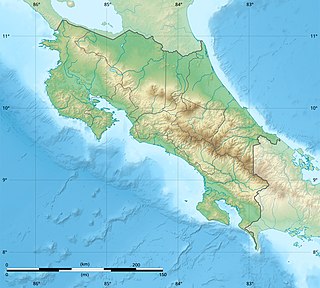
The Camarillas Formation is a geological formation in the Teruel Province of Aragón, Spain whose strata date back to the Early Cretaceous. The sandstones, mudstones and conglomerates of the formation, that due to syn-sedimentary faulting varies greatly in thickness from 300 to 800 metres, were deposited in fluvial, deltaic and lacustrine environments.

The Chorrillo Formation, also named as Chorillo Formation, is a Maastrichtian geologic formation in southern Patagonia, Argentina. The formation is more than 50 metres (160 ft) thick and underlies the Calafate Formation and rests on top of the La Irene Formation.

The Moenave Formation is a Mesozoic geologic formation, in the Glen Canyon Group. It is found in Utah and Arizona.

The Tiki Formation is a Late Triassic geologic formation in Madhya Pradesh, northern India. Dinosaur remains are among the fossils that have been recovered from the formation, although none have yet been referred to a specific genus. Phytosaur remains attributable to the genus Volcanosuchus have also been found in the Tiki Formation.

The Ojo Alamo Formation is a geologic formation in New Mexico spanning the Mesozoic/Cenozoic boundary.

The Rybushka Formation is a Campanian geologic formation in the Penza and Saratov Oblasts of European Russia. Pterosaur, fish and invertebrate fossils have been recovered from the formation.

The Alachua Formation is a Miocene geologic formation in Florida. The claystones, sandstones and phosphorites of the formation preserve many fossils of mammals, birds, reptiles and fish, among others megalodon.

The Citronelle Formation is a Hemphillian geologic formation in Georgia, Alabama, Florida, Mississippi and Louisiana.

The Beartooth Butte Formation is a geologic formation in Wyoming. It preserves fossils dating back to the Devonian period.

The Wasatch Formation (Tw) is an extensive highly fossiliferous geologic formation stretching across several basins in Idaho, Montana Wyoming, Utah and western Colorado. It preserves fossils dating back to the Early Eocene period. The formation defines the Wasatchian or Lostcabinian, a period of time used within the NALMA classification, but the formation ranges in age from the Clarkforkian to Bridgerian.

The San Jose Formation is an Early Eocene geologic formation in the San Juan Basin of New Mexico and Colorado.

The Chalk Butte Formation is a geologic formation in Oregon. It preserves fossils dating back to the Neogene period.

The McKay Formation is a geologic formation in Oregon. It preserves fossils dating back to the Tortonian to Zanclean stages (Hemphillian) of the Neogene period.

The Nestucca Formation is a geologic formation in Oregon. It preserves fossils dating back to the Bartonian to Priabonian stages of the Eocene period.

The Mint Canyon Formation (Tm) is a Miocene geologic formation in the Sierra Pelona Mountains of Los Angeles County, southern California. The formation preserves fossils dating back to the Middle to Late Miocene.

The Coldwater Beds are a geologic formation of the Okanagan Highlands in British Columbia, Canada. They preserve fossils dating back to the Ypresian stage of the Eocene period, or Wasatchian in the NALMA classification.

The Las Tetas de Cabra Formation is a geologic formation in Mexico. It preserves fossils dating back to the Wasatchian of the Early Eocene period.

The Curré Formation is a geologic formation of the Taraba Basin Group in Costa Rica. The deltaic conglomerates preserve fossils dating back to the Late Miocene to Early Pliocene period (Hemphillian).

The El Molino Formation is a Maastrichtian geologic formation pertaining to the Puca Group of central Bolivia. The formation comprises fine-grained sandstones and sandy limestones with stromatolites deposited in a shallow marine to lacustrine environment. The formation has provided fossils of Dolichochampsa minima, and ichnofossils of Ankylosauria indet., Ornithopoda indet., Theropoda indet. and Titanosauridae indet. The tracksite of Cal Orcko is the best known example of the ichnofossil locations of the formation. The ichnofossil of Ligabueichnum bolivianum may be attributed to an ankylosaur. The fossil fish species Dasyatis molinoensis is named after the formation.

The Dorotea Formation is a geological formation in the Río de Las Chinas Valley of the Magallanes Basin in Patagonian Chile whose strata date back to the Campanian to Maastrichtian of the Late Cretaceous.

















